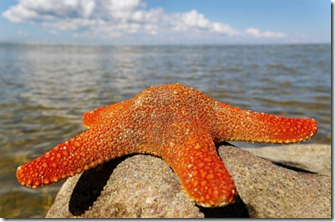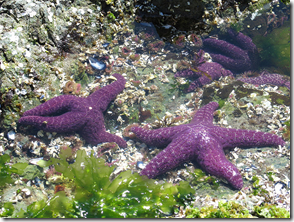15 Stunning Pictures of Starfish Sunbathing
By Simone Preuss, Environmental Graffiti, 25 May 2012.
Starfish belong to a beach vacation like sandcastles and sunburn. They’re not fish, of course, but rather close cousins of sand dollars and sea urchins. Thus, calling them sea stars (or Asteroidae) is less misleading, and it’s the moniker preferred by marine biologists, so there!
Yet, regardless of what you call them, the fact is that just the sight of these stellar sea creatures is enough to excite even the most jaded of beach-goers. Plus, with their knack of showing up in the most romantic spots, they seem to be the perfect gauge for which beaches are the most scenic. Just check out the following 15 images…
Rocks, rippling water and clouds as far as the eye can see… This brooding yet somehow heavenly spot is close to Llico, a fishing village near the city of Arauco in Chile. The starfish seem to be chilling out in the shallows, perhaps waiting for high tide to wash them away, and their bright pink colours are set off wonderfully by the darker background tones.
With such stunning pictures, we may find ourselves running out of adjectives quite quickly! But we’ll persevere! Here, the plain fact is that this lone starfish, photographed on Cuba’s southwestern coast, is sprawled out in a simply breathtaking location. No wonder this place is called Playa Paraiso!
Whether they’re fat and juicy like this guy’s or more slender in appearance, a starfish’s appendages are called arms, or rays. Though all the starfish pictured here have five arms - which is typical of the creatures - they can have even more. Of the some 2,000 species, some often have six or more arms, and those of the Solasteridae family have between 10 and 15. Incredibly, the Antarctic species Labidiaster annulatus can boast as many as 50 rays! Starfish are also famous for their ability to regenerate lost limbs, and are able to pull off this stunt because it’s here that their vital organs are found. Clever stuff!
With its still, crystal water, the reef, and the rocky shore in the background, this picture is so perfect that it almost looks like a fake. Let us assure you, though - it’s not! The photo shows a beautiful location in Australia, namely Lizard Island in Queensland. And photographer Adam Gormley put a lot of effort into getting the shot just right. Here’s what he says about taking it:
“Just 10 meters from the shoreline of Lizard Island are some of the most beautiful reefs in the Great Barrier Reef. I spent a good amount of time snapping shots of this, playing around with flash settings. The flash side of the camera was under the water, so [I got] a nice illumination of the reef, just inches below the water. A beautiful calm day off Sunset Beach made this shot possible.” We’re sure glad it did!
Watch out, extreme close-up! This bright red starfish looks as if it’s waking up from a nap - or a sunbathing session! - and slowly stretching its arms. Yawn! And if you want to know on which rocky beach this gorgeous fellow was snapped, we can reveal that it was in the city of Paphos, on the Mediterranean island of Cyprus.
If these photos are anything to go by, starfish certainly seem to get about the place. Yep, they’re regular globetrotters! In fact, sea stars populate all the oceans on Earth, from tropical to much colder habitats. Some species are happy in shallow waters close to the shore, while others are found in the darkness of the deep seafloor. They all need salt water, though; there are no freshwater starfish.
Here, we seem to have a whole congregation of orange and purplish starfish, casually lazing on rocks - replete with the most atmospheric mist - in a coastal location somewhere in Washington State.
These sea stars are clearly comfortable beside the sea, but did you know that starfish really are consummate marine species? Why? Because they actually have no blood to speak of, instead using filtered seawater for a similar purpose. Called the water vascular system, this hydraulic method of circulating seawater through their bodies is what sea stars use to move, eat, excrete and even breathe.
The locomotion aspect is particularly fascinating. See, starfish get around using various ‘tube feet’ all over their underside. By contracting muscles, they pump water into these tube feet, which thus push against the ground. Then, when the muscles are then relaxed, the tube feet retract. Though they may move only slowly, this is basically how starfish ‘walk’.
If the Flickr comments about this pic are anything to go by, then this is a favourite of many photographers. Still, we can easily see why the moody shot has got the attention of shutterbug peers. A lone starfish sits on a green velvet-like covering in front of rock pools on the Portuguese coast. What’s not to love?
Next, we’ve got a wave-swept starfish that was snapped in Eastbourne, on England’s southern coast. Not far from the famously lofty cliff at Beachy Head, Eastbourne is also well known for its pier, which was built in 1866 during the heyday of the town’s Victorian development. The sunrise, the pier and its reflection, and not forgetting our starfish make this a truly memorable capture.
Photographer John White took this tranquil photo near Port Lincoln, a town located on Boston Bay, at the southern tip of the Eyre Peninsula in South Australia. Not all of Port Lincoln’s beaches are as sheltered as this one appears to be; some of them are known surf spots, while other parts of the coastline are quite rugged. Not this stretch of sand, though. And while the shadows are getting longer, our orange friend here seems content with simply lying in the sun.
Nothing quite says “vacation” quite like a starfish found on the seashore - especially if it’s as bright yellow as this one. Sand, waves and blue skies… “What are you waiting for?” this tropical beach seems to be saying!
As we’ve seen, starfish can vary considerably in colour. The coloration of the common starfish, for example, typically ranges from yellow to orange and red – though purple, blue, green and even white specimens can also be found.
If azure and turquoise waters are where you dwell, then dark blue might be a good color for blending into the shadows. This starfish seems to think so! The perfect composition in blue!
Would this sea star be able to appreciate its wonderful colour tones? Probably not. Starfish have a small simple eye at the end of each of their arms, but they don’t see too well - just enough to distinguish light and darkness. Still, this helps them to make out moving objects - such as would-be predators or prey.
Looking almost like an aquatic version of a fly agaric mushroom with its white dots, this starfish is sitting pretty in its natural environment - on a cold water reef in California. Its only companions are the seaweed and kelp, swaying gently in the water, and a bright orange Garibaldi fish. Nice capture!
Here’s a lovely composition in white, taupe and light blue - though as in some of the other photos we’ve featured here, the starfish in shot looks a little exposed out in the open on the beach - ripe, maybe, for being eaten by something that might think it tasty.
Did you know that starfish are a popular street food in China? Yep, that’s right, it’s not uncommon to see them fried and skewered, alongside other creatures such as seahorses and scorpions. Would you try some?
This rather bedraggled looking orange and black horned starfish is actually underwater. With the water as clear as it is, at first glance it looks like the sea star is lying dry on the beach. The dark spots add to the ‘tough’, dangerous looking image this species of starfish likes to project; horn-like protrusions, they’re designed to scare away potential predators.
This absolutely stunning shot of a lone starfish was taken in Olympic National Park, the most northerly glacier-less spot on North America’s Pacific coast. This UNESCO World Heritage Site boasts both sandy and rocky beaches - the latter of which feature large boulders, like those pictured here.
Because we’re in vacation mode already, here's an image of a beige starfish sunbathing in Greece. We're highly tempted to go out and find the closest beach right now so we can go looking for starfish ourselves. How’s that for a bit of inspiration from a marine animal that’s so small?
Top image: Starfish sunbathing. Source: left image, right image.


Beautiful Pictures and nice Article, I have seen these star fishes in dubai at Lost Chamber Aquarium. the most enjoyable moment in UAE was Morning Safari Dubai
ReplyDelete